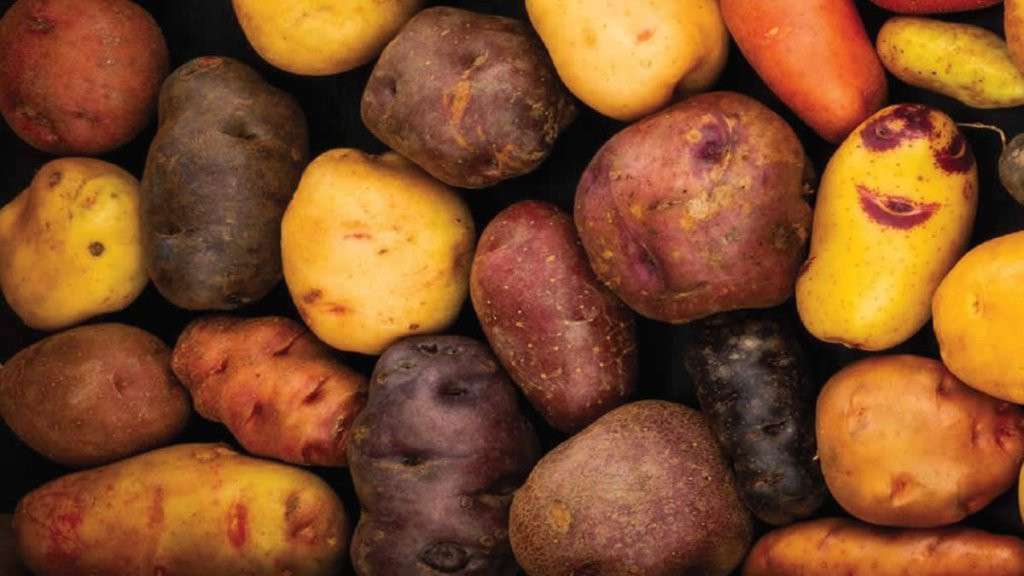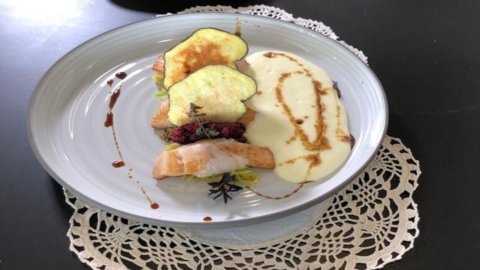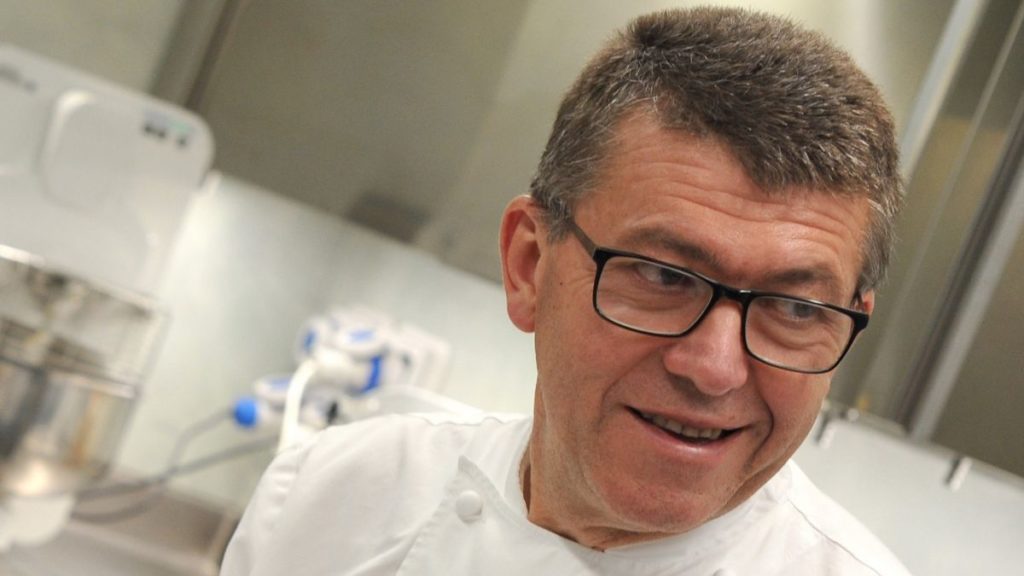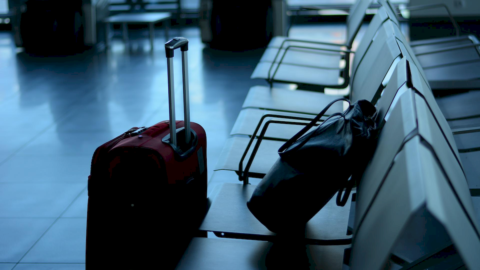He arrived in Valle d'Aosta towards the end of the eighteenth century but it was not cultivated on a regular basis until 1817, the year in which a great famine it affected the region, barely carrying the population. It was then that everyone realized that that potato could offer something to eat. Thus it was that the Verrayes potato, characterized by a shiny purple skin, deep eyes and orange streaks, considered the last traditional variety of the region, rooted in the territory thanks to its soils rich in minerals and a climate with high temperature ranges between night and the day, assumed a leading role in the diet of the Val d'Aosta.
Although its name refers to a municipality in the Media Valle located at an altitude of 1.071 meters above Chambave, the connection with the town does not represent the production area. The name was in fact assigned to it by a Swiss foundation committed to safeguarding biodiversity to which a regional official who came from Verrayes turned. Thus it was that this strange variety of irregularly shaped potato, of light yellow flesh with a fine, intense and persistent flavour, characterized by a slight sweetness and a good sapidity, of high nutritional value, took the name of Verrayes with which it is still today known.
But what we have repeatedly observed for many typical products of Italian agriculture, historical witnesses of biodiversity, also applies to the Verrayes potato: with the arrival of modern varieties, traditional potatoes entered a slow and unstoppable decline. With the extinction of a family and patriarchal agricultural society and the advent of organized markets, the principle of productive profitability takes advantage of the value of tradition. And so also the cultivation of Verrayes began to be abandoned and traces of it were almost lost.
Fortunately in December last year is joined the Slow Food Presidia, which, at the end of a long recovery process by a few enthusiasts, puts it in a new perspective.

Paysage to manager
He indeed came found in 1998 by Giuliano Martignene, technician of the Agriculture Department of the Valle d'Aosta Region, at Covarey (1.250 metres) in the municipality of Champdepraz: the farmer Angelo Berger still reproduced and cultivated this variety. The technician sent some tubers to Switzerland to the Pro Specie Rara Foundation, committed to protecting Alpine agricultural biodiversity. The tubers are sanitized, reproduced and distributed under the name of Verrayes, the municipality of residence of Martignene. The producers who have joined the Presidium have committed themselves to the project with the aim of safeguarding Alpine agricultural biodiversity, which in the 40s has suffered substantial impoverishment to the advantage of cattle breeding, opting for strict production regulations in terms of agro-ecological practices, providing for example the exclusive use of mature manure as fertilizer and the prohibition of pesticides not permitted by organic farming.
Federico Rial, engineering studies in Turin, abandoned in 2015 to return to Valle d'Aosta, to pay homage to the territory in which he was born, he has created an exemplary company dedicated to the conservation and promotion of Alpine potato varieties. The name, “Paysage to eat” is already a program and explains the project that brought it together with the partner Federico Chierico to start the selection and the production of 54 different varieties of potatoes, among which Parli, Lauterbrunnen, Frühe Prättigauer, Fläckler, Weisse Lötschentaler, Safier and, obviously Verrayes, formerly cultivated by the Walser people in the highest settlements of the Alps. and more than a hundred varieties of other vegetables.
“Varieties with unique flavors and textures – he underlines – which tell the precious work of selection and the great symbolic and human value that these seeds had within the rural communities of the high mountains”.
“When, starting in 2014 – adds Federico Chierico – I opened the farm and started working to rediscover this ancient variety, doing research on its link with the Alpine world, I discovered with amazement the important role of guardians , for a very long time, the farmers of this area have played. It is a unique product of its kind, reached us thanks to the seeds that were inherited from father to son and exchanged between families and communities. We fell in love with what traditional varieties represented and we like the idea of working to enhance and re-enact this great cultural and gastronomic heritage”.
The appeal for the gastronomic enhancement of the Verrayes potato launched by "Paysage a manger" was accepted authoritatively by Agostino Buillas, the great starred Chef of Café Quinson in Morgex. And it could not be otherwise Buillas is considered a real priest of the scents of the mountain, of its wild herbs, of the scents of woody mosses, of the flavors of game and of the fish from the rivers, of the intense aromas of the cheeses from the pastures, and the kitchen is the laboratory of this great heritage that knows how to interpret like few others in the exaltation of these lands with their fascinating atmospheres so far from what happens down in the valley in the chaotic city worlds.
Luigi Veronelli who landed at the Café Quinson in one of his gastronomic peregrinations the awarded a very prestigious “Sole” gjustifying his judgment with these words: ”Has it ever happened to you, entering a club, to feel taken back in time? To the Café Quinson by Morgex this sensation is strong and very pleasant. Everything smacks of antiquity: the period of construction of the building dates back to the 1600s and the traces are still clearly visible in the stone vaults of the beautiful cellar or in the wooden cladding of the walls and ceilings…Agostino Buillas, a long-experienced chef, reworks local dishes made with skilful hand and with constant creative research, collected in a menu that varies every day, depending on the market and the season ... the bread deserves special mention, homemade daily and enriched with many flavors: herbs, walnuts, coriander and bread sticks with mountain butter”. It could therefore not be missing from its refined menu a dish dedicated to the Verrayes potato, a tribute to a poor product that embodies so much history.
The recipe: "Verrayes potatoes mousse and alpine fontina cheese, Morgex salmon trout, Lard d'Arnad, Boudin, savoy cabbage and apple balsamic dressing"
Ingredients for people 4
1 medium sized salmon trout
12 slices of Valle d'Aosta dop Lard d'Arnad
2 "boudins"
1 small savoy cabbage
1 glass of Prié Blanc
400 g Verrayes potatoes
200 g of fontina dop from the pastures
200 ml of liquid cream
250 ml of milk
apple balsamic dressing to taste
extra virgin olive oil to taste
salt to taste
Procedure:
Peel the potatoes and cut them into small cubes. In a small pan, cover them with milk and cook over moderate heat for 10 minutes. Clean and bone the salmon trout, cut the fillets into slices about 2 cm in size.
Cut the cabbage into julienne strips, once browned, pour a glass of Prié Blanc and stew it.
Cut the Fontina into cubes, cover it with cream in a glass container, cover with plastic wrap and cook in the microwave for about 4 minutes, obtaining a fondue.
Blend the cooked potatoes, add the fondue. Mix everything together, pass through a sieve, pour into a thermal siphon with two cans of gas.
Cut 1 potato into 2mm slices, place them on a silpat or on baking paper, salt them lightly and put them in the microwave for about a minute, until they reach a crunchy consistency
Brown the trout in a frying pan with very hot extra virgin olive oil, first on the skin side and then on the other side; remove the browned skin and brown the fish again. Wrap each piece of trout with a slice of Lard d'Arnad, place them in the pan away from the heat and cover with a lid.
Place the "boudins" in a glass container and put them in the microwave for about 1 and a half minutes.
Finish:
In a flat dish, place the salted cabbage sauté on the bottom, arrange three trout fillets alternating with a quenele of boudin, siphon the cream of potatoes and fontina cheese, decorate with potato chips and wild thyme, perfume with the rennet apple balsamic dressing.
Café Quinson
Piazza Principe Tomaso 10
11017 Morgex AO
Tel: 39 0165 809499
Email: info@cafequinson.it






